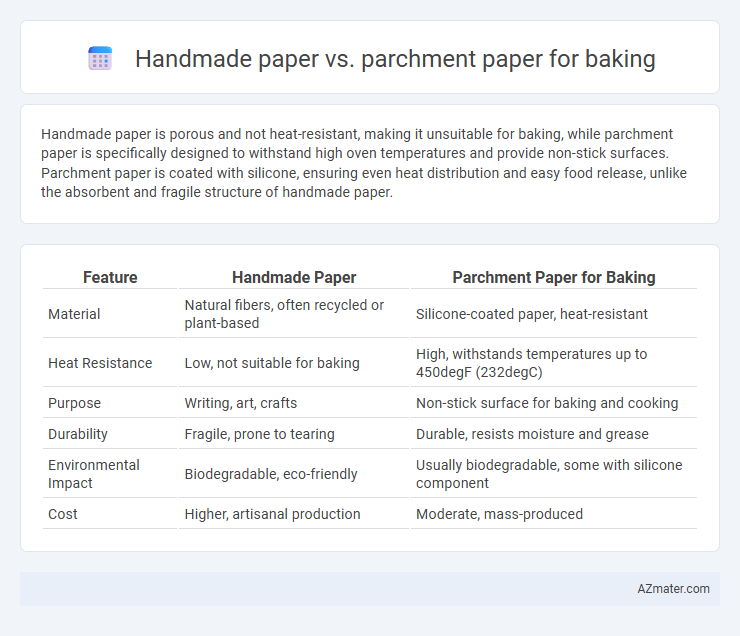Handmade paper is porous and not heat-resistant, making it unsuitable for baking, while parchment paper is specifically designed to withstand high oven temperatures and provide non-stick surfaces. Parchment paper is coated with silicone, ensuring even heat distribution and easy food release, unlike the absorbent and fragile structure of handmade paper.
Table of Comparison
| Feature | Handmade Paper | Parchment Paper for Baking |
|---|---|---|
| Material | Natural fibers, often recycled or plant-based | Silicone-coated paper, heat-resistant |
| Heat Resistance | Low, not suitable for baking | High, withstands temperatures up to 450degF (232degC) |
| Purpose | Writing, art, crafts | Non-stick surface for baking and cooking |
| Durability | Fragile, prone to tearing | Durable, resists moisture and grease |
| Environmental Impact | Biodegradable, eco-friendly | Usually biodegradable, some with silicone component |
| Cost | Higher, artisanal production | Moderate, mass-produced |
Introduction to Baking Papers
Handmade paper and parchment paper differ significantly in baking applications due to their composition and heat resistance. Parchment paper, made from cellulose fibers treated with silicone, provides a non-stick, heat-resistant surface ideal for baking and roasting, preventing food from sticking and ensuring even heat distribution. Handmade paper, usually crafted from natural fibers without heat-resistant coatings, lacks the durability and non-stick properties necessary for baking, making it unsuitable for oven use.
What is Handmade Paper?
Handmade paper is crafted by manually pulping natural fibers such as cotton, linen, or recycled materials, resulting in a textured, eco-friendly product primarily used for arts and crafts rather than baking. Unlike parchment paper, which is coated with silicone to provide non-stick and heat-resistant properties suitable for baking, handmade paper lacks the durability and heat resistance needed in oven use. Choosing parchment paper ensures reliable performance for baking tasks, while handmade paper serves decorative and artistic purposes.
Understanding Parchment Paper
Parchment paper is a heat-resistant, non-stick paper specially treated with silicone, making it ideal for baking and cooking as it prevents food from sticking and ensures even heat distribution. Unlike handmade paper, which is often porous and less heat-tolerant, parchment paper withstands high oven temperatures without burning or curling. Understanding these properties helps bakers choose parchment paper for consistent, mess-free results in recipes requiring precise heat exposure.
Key Differences Between Handmade and Parchment Paper
Handmade paper is crafted from natural fibers and offers an eco-friendly, rustic texture but lacks the non-stick, heat-resistant properties essential for baking. Parchment paper is specifically treated with silicone, ensuring a non-stick surface that withstands high oven temperatures up to 420degF (215degC). Unlike handmade paper, parchment paper provides consistent heat distribution, easy food release, and prevents sticking or burning during baking processes.
Heat Resistance and Performance
Handmade paper has low heat resistance and is not suitable for baking as it may burn or catch fire easily, while parchment paper is specifically designed for baking with a heat resistance up to 420degF (215degC). Parchment paper's non-stick surface ensures even heat distribution and prevents food from sticking, enhancing baking performance. Handmade paper lacks the coating and structural properties needed for cooking applications, making parchment paper the preferred choice for reliable heat endurance and cooking results.
Impact on Food Flavor and Texture
Handmade paper lacks the non-stick, heat-resistant coating of parchment paper, which can affect baking outcomes by sometimes causing food to stick or brown unevenly. Parchment paper provides a smooth, even surface that prevents sticking and promotes consistent texture, preserving the intended crispness and moisture balance of baked goods. The neutral composition of parchment paper ensures it does not impart any off-flavors, whereas handmade paper may inadvertently introduce subtle earthy or fibrous notes affecting the food's flavor profile.
Safety and Chemical Composition
Handmade paper is generally composed of natural fibers and lacks synthetic chemicals, making it less likely to release harmful substances when exposed to heat during baking. Parchment paper, often treated with silicone or other non-stick coatings, provides a safe, heat-resistant surface but may contain trace amounts of these chemicals, which are considered food-safe under regulated temperatures. Prioritizing chemical-free and unbleached handmade paper can minimize chemical exposure, but parchment paper remains the preferred option for consistent non-stick performance and heat tolerance.
Sustainability and Eco-Friendliness
Handmade paper, crafted from natural fibers without chemical bleaching, offers a sustainable and biodegradable alternative to conventional parchment paper often lined with silicone or coated with non-stick chemicals. Its eco-friendly production reduces environmental impact by minimizing resource consumption and promoting renewable materials, whereas parchment paper frequently ends up in landfills due to limited compostability. Choosing handmade paper supports zero-waste baking practices and contributes to a circular economy through its compostable and reusable characteristics.
Cost and Availability
Handmade paper is generally more expensive and less readily available compared to parchment paper, as its artisanal production process limits mass distribution. Parchment paper, widely manufactured and sold in grocery stores and online, offers a cost-effective and convenient option for baking due to its consistent non-stick and heat-resistant properties. Budget-conscious bakers typically prefer parchment paper because it balances affordability, accessibility, and reliable performance in the oven.
Best Uses and Recommendations
Handmade paper is best suited for decorative purposes and artisanal packaging but is not recommended for baking due to its uneven texture and potential absorbency. Parchment paper, especially silicone-coated varieties, offers excellent non-stick properties and heat resistance, making it ideal for lining baking sheets and preventing food from sticking. For reliable baking results, parchment paper is recommended because it withstands oven temperatures up to 420degF (215degC) and provides consistent performance.

Infographic: Handmade paper vs Parchment paper for Baking
 azmater.com
azmater.com